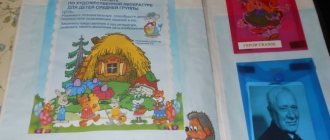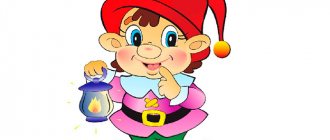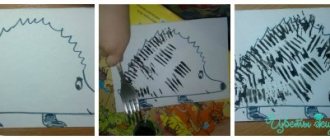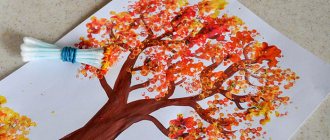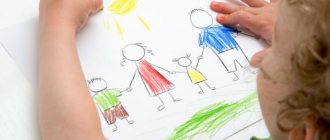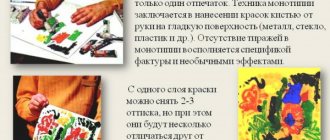Progress of the lesson.
Organizational moment: children stand in a circle.
Educator: Guys, show your palms , stroke them, clap your hands , close your eyes with your palms , rub your cheeks with your palms . palms can do . also draw birds with your palms . (Children sit at tables.)
Educator: Guys, why did the birds fly away ?
Children: It’s getting cold, the birds have nothing to eat .
Educator: Well done, guys! Guess the riddles about what birds they are talking about!
He steals hemp. (sparrow)
Blue scarf, dark back.
Little bird , call her. (titmouse)
Children: These birds are wintering birds.
Educator: Well done! Let's draw a bird . Before drawing we must do finger exercises.
on your palm ,
Feeding the cute titmouse
The bird pecks the grains,
Sings songs to children:
I fly all day.
Educator: Look at my palm , it seems to me that it looks very much like a bird. And what do you think? Where is the bird's beak? Where's the neck? Show the body of the bird. What a wonderful fluffy tail. (The teacher shows on his palm , the children on theirs).
Preparing to paint an autumn still life
The teacher asks the children what time of year there are many bright and rich shades of warm colors in nature; nature literally breathes warmth. This time of year has always attracted artists, poets, and composers with its luxurious beauty; they admired this time of year and conveyed their admiration to people through their vision of the beauty of nature. How many famous people have left us their masterpieces in painting, poetry and music! What time of year do you think it might be? (autumn). What time of year is it now? What autumn months do you know?
What is the difference between early autumn and golden autumn? (In September, autumn is just beginning. The first yellow leaves appear on birches, maples bloom with yellow and red foliage. They say about such an autumn - early autumn. In October, all the trees dress up in autumn outfits, the leaves begin to fall. They say about such an autumn - golden, lush autumn ).
How do we know that late autumn has arrived? (In November, there is almost no foliage on the trees, there are frequent cold rains, frosts set in, and the first snow falls. This is called late autumn).
Autumn has its own colors. What colors of golden autumn do you know? (Red, yellow, orange, green, purple, warm, crimson, golden).
More useful materials for talking with children: A selection of poems about the colors of autumn for drawing classes with preschool children can be found here in the article about drawing an autumn forest using the technique of leaf prints on paper.
The teacher invites children to draw an autumn still life and shows how adult artists and children who are learning to be artists draw still lifes.
How to analyze these still lifes with children: The teacher shows the children a table with warm and cold colors and the still life invites them to think through what color palette the artist tells us about autumn in his still life. Does this painting have more warm or cool colors and shades?
At the end of the conversation, the adult asks: “What colors will you use to tell your story about autumn in your future still life? Think about it, and you and I will begin to draw an unusual autumn still life.
The still life will consist of maple leaves that stand in a vase. We will draw maple leaves using our palms.”
Article on the topic: “The role of hand drawing as an important factor in the development of preschool children”
Materials: saucers with gouache, brush, paper of any color, large format sheets, napkins.
Method of obtaining an image: the child dips his palm in gouache and paints it with a brush and makes an imprint on paper. They draw with both the right and left hands, painted in different colors. After work, wipe your hands with a napkin, then the gouache is easily washed off.
The types of non-traditional drawing techniques are quite diverse, and in each technique the child gets the opportunity to reflect his impressions of the world around him, convey images of the imagination, translating them into real forms using a variety of materials. For example, if we take drawing with a finger or palm, this drawing helps the child feel the freedom of creativity and allows interaction with visual material (with paint) without a brush. When drawing with fingers or palm, the child receives extraordinary pleasure from tactile contact with paint, paper, and water.
And there are several finger painting techniques.
1. Drawing on wet paper.
2. Draw with a fist from the side of the thumb (beautiful roses, shells, snails will come out)
3. Draw with your palm, while your fingers can be closed (fish - one palm attached horizontally to the paper).
4. Finger painting on glass.
5. Draw with a half-open fist, this way you can draw a rainbow, hills, banana.
The paper can be wetted completely with a wide brush. From one touch of his fingers such a beautiful spot spreads on the sheet. You can also draw using this technique on paper, on an easel. You can work carefully, in this case the paint will flow down.
Recently, a huge selection of special paints for finger painting has appeared - they are easily washed off your hands and wash well from clothes.
I have been working in a children's home for 16 years, and I have observed how the content and tasks of the visual activities of early childhood children change. Currently, I am using new and quite interesting programs, trying not to impose my point of view on the world around the children, but to give them the opportunity to express themselves and realize their creative potential. The main program I work on is the new author’s program by I.A. Lykova “Colored Palms”. She became a discovery and support in my further work.
I begin my work using non-traditional finger and palm drawing techniques from the middle group according to the principle “from simple to complex.”
In my work, I pay a lot of attention to teaching children to draw using non-traditional techniques with fingers and palms. Interesting and exciting for children! During art classes, drawing with non-traditional techniques allows them not to be afraid of doing something wrong. Finger and palm painting allows children to feel positive emotions. The classes are designed in such a way that the end result is work that can be used in the design of a kindergarten and displayed so that parents and their children can be proud.
Progress of the lesson:
1. A sunbeam and asks for help.
2. Children are ready to draw a lot of rays from the sun to make it lighter, warmer, and the snow to melt faster. Showing a method of applying gouache to the palm and imprinting it on paper.
4. Evaluation of work. Reading poems
“
Sunshine , sunshine ” Sunshine , sunshine , Look out the window, Shine a little light, I’ll give you some peas!
Olga Chusovitina “Me and the Sun ”
The sun is shining through my window in the morning, which means it’s time for me to go to kindergarten. I quickly wash my face, brush my teeth myself, and I can hear the cheerful noise of birds outside the window. The birds are happy that spring has come,
5. Games with a sun bunny .
Synopsis of the physical education lesson “Let's go on a flight” (first junior group) Synopsis of the physical education lesson 1st junior group. “Let's go flying.” Venue: on the street. Objectives: 1. Strengthen the ability to perform.
Summary of the integrated lesson “Grandfather Frost’s Birthday!” (first junior group) Summary of the integrated lesson “Grandfather Frost’s Birthday!” (1st junior group) Tasks: Introduce children to the main character of the New Year. Summary of the integrated lesson “Needles for a hedgehog” (first junior group) Integration of educational areas “Artistic and Aesthetic”, “Speech Development”, “Cognitive Development”, “Physical Culture”. Synopsis of the integrated lesson “Oh, the red rowan tree” (first junior group) Synopsis of the integrated lesson “Oh, the red rowan tree” (first junior group). Program content: Expand your understanding of trees.
Abstract of the educational activity for drawing "Balloons" (first junior group) (2-3 years) Abstract of the educational activity for visual activities (drawing) "Balloons" First junior group (2-3 years) Objectives:.
GCD summary for drawing “Let's decorate a plate” (first junior group) GCD summary for drawing “Let's decorate a plate.” (first junior group) Integration of educational areas: • cognition • socialization;.
Summary of the modeling lesson “Mother Duck and Ducklings” (first junior group) Purpose: To arouse in children the desire to depict, sculpt; Develop fine motor skills and creative abilities; Continue to master some. Summary of the lesson on plasticineography “Ladybug” (first junior group) Program content: • Form children’s ideas about the inhabitants of their immediate environment, teach them to recognize and name animals by their bright colors.
Source
